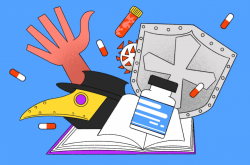Three popular science books
Everything That Moves. Excursions Into the Turbulent Universe. From Space Orbits to Quantum Fields by Alexey Semikhatov
Last year, ITMO.NEWS teamed up with scientists to figure out whether sci-fi novels and Hollywood blockbusters are telling the truth when it comes to moving at the speed of light and traveling through wormholes or black holes. We also described in detail the practical applications of special relativity. Another great source of insights about the core tenets of the Universe is Dr. Alexey Semihatov, a leading research associate at the I. E. Tamm Theory Department of the Lebedev Physical Institute of the Russian Academy of Sciences and a renowned science communicator. His work was recognized by the Russian Academy of Sciences with a prize as the Best Popular Science Book About Scientists and Scientific Development and even was included in the shortlist of the Enlightener Prize (a prestigious Russian literary prize for popular science literature – Ed.).
How does spaceflight work? Is intergalactic travel even physically possible and how is it connected to the special theory of relativity? What is time dilation and are there any other ways to go faster than light? The answers to these and many other questions will be revealed by the author over the course of eleven chapters – each one an excursion into the Universe.
The Gospel of LUCA. Uncovering the Animal Kingdom’s Family Tree by Maxim Vinarsky
How did life emerge on Earth and who is the common ancestor of all living beings? Many scientists are faced with these questions. Among those looking for the answers is Dr. Maxim Vinarsky, a professor at Saint Petersburg State University and a leading research associate at the S.I. Vavilov Institute for the History of Natural Science and Technology. He takes his readers four billion years into the past to meet LUCA (the last universal common ancestor). The author speaks of how biologists determine the relations between different kinds of animals, how multicellular organisms evolved, and why homo sapiens came to be the way they are. “The Gospel of LUCA. Uncovering the Animal Kingdom’s Family Tree” was also included in the shortlist of the Enlightener Prize.
Linguists of the Thaw by Maria Buras
Nowadays, it is hard to imagine life without online translation services, which owe their existence to the combination of two scientific disciplines – math and linguistics. This book takes its readers into the USSR at the time of the Khrushchev Thaw to witness the birth of computational linguistics, the formation of the community of scientists who specialize in using machines to process text, and how the events of that time influenced this new field of study. What makes the book special is that it’s based on the accounts of the still-living scientists who took part in the events being described. They were interviewed by Maria Buras, a linguist and the finalist of the NOS and Big Book literary prizes. Their interviews are also complemented by written notes left by contemporary language scholars. Notably, “Linguists of the Thaw” was also included in the shortlist of the Enlightener Prize.
Three popular science podcasts
Credit: yanishevska.photo / photogenica.ru
This Is a Signal
In September 2022 Ivan Shunin, the deputy editor-in-chief of the popular science web portal N + 1, and Alexander Dubov, the portal’s senior editor, launched their free podcast This Is a Signal, with 15 episodes released so far. For instance, the authors have already discussed everything that we know about climate change with Alexander Chernokulsky, a climatologist and senior researcher at the A.M. Obukhov Institute of Atmospheric Physics of the Russian Academy of Sciences. You can also find out how and why scientists have to prove that they’ve actually made a new discovery, what the language of the future will be like, and how immortality may be achieved.
Anthropogenesis.ru
Are X-rays dangerous to humans? Is the number of people affected by diabetes increasing? Does retrograde Mercury impact the future? Science journalist Alexander Sokolov and anthropologist Stanislav Drobyshevsky are ready to bust such myths. On their podcast and YouTube channel Anthropogenesis.ru, they team up with guests to talk about which commonly held beliefs regarding science turn out to just be misconceptions. Occasionally, scientists even engage in a competition called Fake-ring, where they come up with ideas that emulate pseudoscience and try to pass them off as true to their colleagues.
Sooner or Later
How can we wear digital clothes? Who owns things produced by neural networks? How are cybercrimes solved? And, last but not least, how do you pack for a trip to Mars? These are all questions that will need to be answered sooner or later, but while there is still some time to spare, Alina Belyat, the producer and editor at the Libo/Libo podcast studio, will use it to discuss these issues with economists, sociologists, engineers, and other experts.
Three popular science YouTube channels
Credit: AnthonyMujica / photogenica.ru
PostScience
If you always wanted to know how real scientists work and what fundamental problems they tackle, then you should take a look at the YouTube channel PostScience. It publishes lectures by Russian researchers on a wide range of topics – from philology and history to pharmacology and IT. For example, some of the videos explain how genes influence whether or not we can absorb certain types of medicine, when artificial intelligence will become smarter than us, and why the definitions of verse meters we were taught at school might not always be correct.
SciencePRO
Do you want to learn how breathtaking satellite images are produced, how the depth of Lake Baikal can be measured, or even understand complex topics like Perelman’s proof of the Poincaré conjecture or the use of perovskite solar cells? The Russian science education project SciencePRO, which was recognized two times with the national award For Devotion to Science, is here to help!
What If
If you are interested in hypotheticals like: “What if I turned into a cat?” or “What happens if another Earth is found?”, then the YouTube channel What If is just the thing for you. It uses animated shorts to share fun facts and hypothesize on the outcomes of different made-up scenarios.





